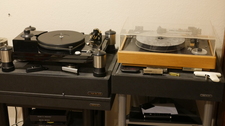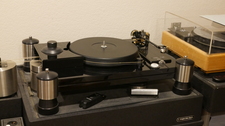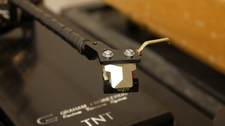It’s the time of year for saving money!
Michael Trei has been professionally setting up turntables for more than a quarter century, which is almost as long as I’ve known him. When I found out he was coming to the 2015 Rocky Mountain Audio Show I asked him if he would have any time to give my 20-year-old VPI TNT III a cleaning and adjustment. At first Michael wasn’t sure whether he would have time, but the stars aligned in my favor when the vintage Mercedes he was driving across country from Los Angeles to North Carolina needed new master and slave cylinders for its brakes and he found himself spending an extra day in Denver. Since Michael lives in NYC, this was an opportunity I could not pass up.
 I currently have two VPI turntables in my main system. The first is a thoroughly tricked-out VPI HW-19 with a early PLC speed control with an original Souther Linear tracking arm mounted with a AJ VanDenHul rebuilt Denon 103C cartridge. That was not the turntable I wanted Michael to set-up. I learned from Lou Souther himself how to set-up his arm and once set-up even the move from country to city didn’t disturb its geometry. Also Michael made it very clear that he did not want to set-up my Souther.
I currently have two VPI turntables in my main system. The first is a thoroughly tricked-out VPI HW-19 with a early PLC speed control with an original Souther Linear tracking arm mounted with a AJ VanDenHul rebuilt Denon 103C cartridge. That was not the turntable I wanted Michael to set-up. I learned from Lou Souther himself how to set-up his arm and once set-up even the move from country to city didn’t disturb its geometry. Also Michael made it very clear that he did not want to set-up my Souther.
But that was fine since I wanted Michael to work on my other turntable, the TNT. This unit began life as a TNT 1, but it morphed over the years with the addition of the air-filled support columns, Brightstar air base, original VPI TNT turntable stand, and additional flywheel assembly into a TNT III. All forward evolutionary progress on this turntable ceased around 1996. The TNT is mounted with a Graham 1.5 tonearm with an original metal tonearm wand. I had two ceramic wands but they both developed cracks rendering them useless. The tonearm has a Clearaudio Victory H cartridge that was tracking at 1.8 grams.
The principal reason I decided to enlist Michael’s services was that the HW-19 with the Souther Arm was trouncing the TNT. Something wasn’t right and I had run out of solutions. I noticed the disparity after I replaced the TNT’s original PLC box with the latest SDS speed control – The sound changed in a negative way – it got harmonically thinner, harder during dynamic peaks, and less musical overall.
 Enter, stage right, Michael Trei with his array of tools. First he disassembled all the TNT’s belts and pulleys, cleaned and lubricated the idler wheels, and removed many years of accumulated dirt. After cleaning, he carefully leveled the platter and chassis, reassembled the turntable and began checking, readjusting, and then fine-tuning the tonearm and cartridge alignment. He found that the Clearaudio Victory’s cantilever was slightly off to one side, which required turning the entire cartridge body to get the cantilever aligned properly with the record grooves. After getting the alignment and overhang right Michael increased the stylus force to 2.2 (which was the minimum recommended force for this cart). I suspect that during my move the weight got changed. As for the misalignment, that was on me. Silly audiophile! How could I assume during the initial installation that a new phono cart actually had a perfectly aligned cantilever! The final step in the set-up was adjusting the SDS speed control so that its speeds for both 33 and 45 were spot on.
Enter, stage right, Michael Trei with his array of tools. First he disassembled all the TNT’s belts and pulleys, cleaned and lubricated the idler wheels, and removed many years of accumulated dirt. After cleaning, he carefully leveled the platter and chassis, reassembled the turntable and began checking, readjusting, and then fine-tuning the tonearm and cartridge alignment. He found that the Clearaudio Victory’s cantilever was slightly off to one side, which required turning the entire cartridge body to get the cantilever aligned properly with the record grooves. After getting the alignment and overhang right Michael increased the stylus force to 2.2 (which was the minimum recommended force for this cart). I suspect that during my move the weight got changed. As for the misalignment, that was on me. Silly audiophile! How could I assume during the initial installation that a new phono cart actually had a perfectly aligned cantilever! The final step in the set-up was adjusting the SDS speed control so that its speeds for both 33 and 45 were spot on.
It took Michael about 2 ½ hours to completely re-set-up my VPI TNT. After he was finished and we sat down to listen. I have duplicates of a number of albums, so I put one on each turntable. After his ministrations the HW-19 was no longer my best-sounding turntable. Now the TNT sounded more incisive with superior dynamics and a more precisely centered image. But what surprised me the most was that after Michael’s work was how similar the two turntables sounded. The sonic similarities far outweighed the differences, but the differences were sufficient that I found it easy to identify one from the other in blind tests.
 So, after going through the turntable re-set-up process would I recommend it to other audiophiles whose premium turntables have been sitting, un-restored, for a number of years? Yes, I would, especially if the turntable was set up originally by its owner. Michael mentioned that he often he finds misaligned cantilevers even on brand new carts and more often than not the installer did not correct for the problem. Guilty as charged, your honor…
So, after going through the turntable re-set-up process would I recommend it to other audiophiles whose premium turntables have been sitting, un-restored, for a number of years? Yes, I would, especially if the turntable was set up originally by its owner. Michael mentioned that he often he finds misaligned cantilevers even on brand new carts and more often than not the installer did not correct for the problem. Guilty as charged, your honor…
I returned Michael to the German Motors repair shop in Lakewood, CO in the mid afternoon. He waved goodbye and began the rest of his cross-country trek. His next stop was going to be Chad Kassam’s facility in Kansas to check out Chad’s newest releases (including the Beach Boys Pet Sounds) and collect Chad’s collection of Linn turntable parts for future restorations. Linn LP12s are one of Michael’s specialties.
If you want to make sure your turntable is performing as well as it possibly can I recommend setting up an appointment with Michael Trei. Although he might be horrified to read this, but he’s the closest thing to a “turntable whisperer” that you’ll find.





